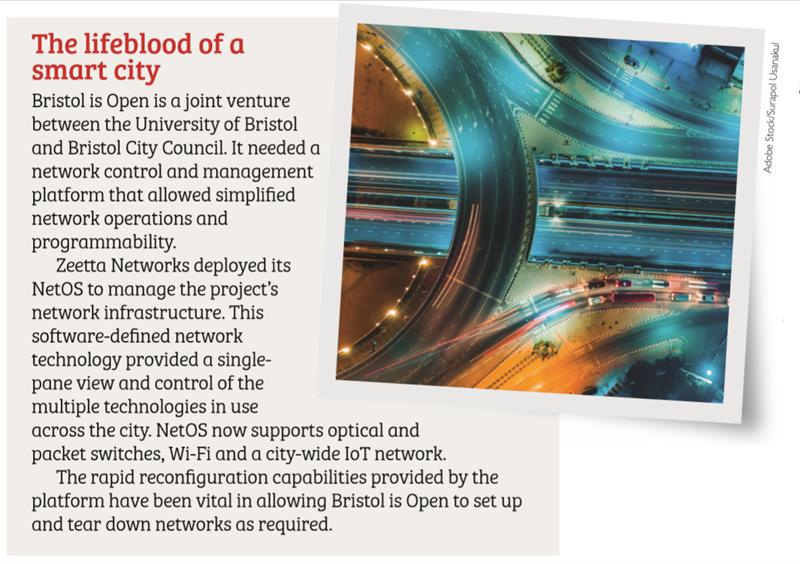The concept of a smart city promises to simplify and enhance many aspects of life in an urban environment. Yet this is no longer a new idea. Smart city projects have been under way for a decade or more in various locations around the world. Is this the decade when cities become truly smart?
Stu Higgins, head of smart cities and IoT at Cisco, believes all signs point to smart city projects starting to deliver on expectations. The thing that has changed, he says, is that “the technology is now delivering on the promise”.
He adds that city leadership teams have woken up to the idea of “frictionless cities”, which is “about removing hassle from everybody’s daily lives”. He explains that a one-size-fits-all approach will not work; every local government or local authority must evaluate which technologies will meaningfully improve the lives of their citizens. “It’s about how you can use the same underlying technology to deliver benefits for different groups of people. I don’t think there’s any killer application. It’s those small improvements that make the [city or town] a nicer place.”
What does all of this mean for a real-world smart city project? Theo Blackwell, London’s chief digital officer, explains London’s current priorities within the context of a city that is already a ‘smart’ in many respects.
Blackwell says: “London has a great track record on innovation. There are some really important London-wide achievements, such as contactless payments on the Tube and the Oyster card before then, but there was a sense that we weren’t greater than the sum of our parts.”
London has a complex structure, with 32 boroughs, 50 NHS trusts and a vibrant technology ecosystem. A lot of innovation was happening in pockets across the city, but there was no route to collectively solve its big problems. “All of those things together have to be presented in a unified way, otherwise they just become a collection of different initiatives,” Blackwell says.
In 2018, the city created its Smarter London Together roadmap, following what Blackwell says was “the biggest listening exercise on smart technologies” that London had ever done. London’s City Hall engaged directly with the public to understand their views on what the priorities should be. The number-one thing the city needed to do, according to citizens, was “put people first” when evaluating or implementing technology.
Blackwell adds: “Quite often, technologists get carried away with their invention and don’t think about how people are part of the design. The challenge that we can see from AI at the moment, for example, is that it’s been built with inbuilt biases. Consideration of the diversity of people has not been at the forefront of people’s minds.
“You need to design your technology around people, and that’s not just a glib statement saying, ‘put people first’. It’s a challenge for user-centred design. That’s the number-one thing we champion in City Hall, to make sure that user-centred design is part of what we do. And that’s a change from just buying and implementing technology systems.”

Intelligent data
What lies behind smart cities is data, and existing projects have been good at generating data – but that data is not necessarily then used or applied in the right way. Open data, increasing numbers of sensors, and the growth of the Internet of Things – all of this gives us a vast array of dynamic, real-time data that can build a picture of what is happening across a city in a completely different way.
Cisco’s Higgins highlights CityVerve, a smart city demonstrator which ran between July 2016 and July 2018 in Manchester. The project was funded by the Department for Digital, Culture, Media and Sport and Innovate UK, and involved a consortium of 21 organisations led by Manchester City Council with Cisco as the lead industry partner.
The CityVerve project delivered an air quality management application based on modelling, monitoring and analytics. This provided individuals with personalised nudges when the weather, traffic or other factors might affect their breathing. Higgins explains that “it’s when you start to combine multiple different datasets that you gain real insight and turn that into actions that can improve things for people”.
This chimes with the view of Blackwell, who explains that data analysis “gives [London] a more nuanced understanding of the bigger picture. You can spot the desire lines of the city. Ultimately, it’s not just going to be a city built on sensors. It’s going to be about the interrelationship between the technology, the data collected and human beings making decisions and designing things or creating solutions. The human element of this is vitally important. You can’t just do it through technology alone. Technology is just an enabler to augment human beings in the job that they do.”
In London, a big project for the year ahead is to evolve the London data store. Blackwell describes it as a central register of open and secure data in the capital. Some cities have a central, unified data platform that pools all the information. London is instead cataloguing where different datasets sit, and who is responsible for access.
Blackwell explains that London’s problem-based approach means that every project starts with the question ‘what are we trying to achieve here?’, or ‘what problem are we trying to solve?’. The answer is never to create a big lake of data, which could create new problems around trust and security.
He adds: “Data enables us to have deeper insights and to propose bolder solutions. The ultra-low emission zone is an example of that.”
London is also doing work with the Turing Institute around gathering more data or different datasets on air policy, so citizens can receive an Air Quality Report on what the air quality is going to be like the next day. Like the CityVerve project, this would involve a complex analysis of weather and traffic patterns.

Security
As smart city projects mature, managing the security risks that go hand-in-hand with deploying technology is becoming a critical issue. Cities must consider what vulnerabilities are created by installing 50,000 connected streetlights or putting sensors into 5,000 bins.
Cisco’s Higgins cautions: “No local authority has enough staff to manage hundreds of thousands of devices, so you have to rely on the network to take care of a lot of that day-to-day stuff. A lot of this is simple. If you’ve got a sensor in a bin, for example, it should never be able to see your HR database. That sounds incredibly obvious to say, but a lot of networks are architected in a very flat way, so people never think that they need to isolate devices.”
He explains that local authorities need to ensure they are putting the right policies in place. In practice, this means that “smart IoT devices can only communicate with each other and with the applications that are necessary for them to do a particular job”.
To understand what is at stake here, local authorities need to think like a hacker. Higgins says: “Let’s face it, if I was going to hack your network, I wouldn’t try and get into it through a computer or data centre, or through your corporate network. I’d try and find an outlier device, like a streetlight or something in a waste bin, and try and get in that way.”
Teething problems
Smart city projects are maturing in many respects, but full-scale deployment is not an easy next step. Eric Woods, research director at Navigant Consulting (now Guidehouse), evaluates what is happening with diff erent smart city projects across the world. He says: “There’s always going to be a challenge for a city as it moves from its pilot phase into rolling out projects at scale. The real benefits of smart city innovation come from a cross-sector, platform-based approach that looks at issues outside of traditional silos.
“I think we’ve gone a long way in terms of trying to make that work, but making it work at scale remains a challenge. There are some really interesting developments around data sharing and data platforms and how they can be used to create innovative approaches that are cross-sector.”
One example of that is Cisco’s smart city management platform, Kinetic for Cities. Higgins explains that this is “a layer that sits above the physical infrastructure and enables you to pull data into one place and then share it in an open, secure way”.
Kinetic for Cities is used by cities across the world including Kansas City, Copenhagen and Jaipur to create a unified view of deployments. The subscription-based service uses standardised APIs to aggregate data, so information can be securely analysed, responded to and packaged without being limited by specific protocols of individual smart city assets.
Woods adds: “Finance is always going to be there as a challenge. Cities are rarely awash with money to make major investments, so they need to find the right business model that allows them to make an investment. [If you look at] what’s happening with connected street lighting, those projects are moving forward because you can make significant energy savings and cost savings by the move to LEDs, and that can help fund the broader upgrade programme.”
For London’s Blackwell, a lot of the barriers to scale are organisational. He says: “Every city will have a similar set of challenges around scaling great ideas. At the heart of that is the friction in the system that comes from diff erent bits of government and different teams working together not as effectively as they should.”
He adds: “It’s easier said than done to scale up an idea. It’s great to have successful pilot projects that you want to scale up, but first, we need to fix the plumbing. First, we need to have common ways of working, common ways of problem-solving, setting common standards for data. You need to understand what the foundations for future growth are because, of course, we’ve already bought and implemented technology solutions that have different ways of working, and these are all grown on top of each other.”
This means that London’s goals are “completely different” from “an entity that you might set up today”. Blackwell adds that London is not looking to “place bets on technology”, it just needs to be able to express its needs “in a way that the ecosystem can respond to and have conversations about solving problems”.
Emerging avenues for development
One area that is gaining momentum is around sustainability. Navigant’s Woods says: “Sustainability has always been part of smart city projects, but that’s come much more to the fore. We’re going to see cities having to think much more deeply about what it means to reach their targets in terms of their transportation policies, the energy efficiency of city buildings, how they integrate with their local energy systems.”
As we step into the 5G era, Woods also expects smart city projects to experiment with the new capabilities presented by the new standard. He says: “I expect 5G to have much more of an impact than previous generations of cellular networks. You can see that here in the UK with London, Bristol, the West Midlands and others being keen to be seen at the forefront of 5G experimentation and adoption.”
What is clear is that what a ‘smart city’ means will continue to be defined by the problem being addressed. Pilot projects across the world have demonstrated what can be achieved with different technologies and opened the door to ideas that are scalable. Progress rests on ensuring citizens understand how a project is designed to benefit them, making the most of existing investments, and overcoming organisational barriers that might be holding back success.



